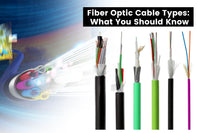Contents
Thanks to its excellent performance, optical fiber has become the medium for telecommunications and computer networks. So here comes the question: Is the bandwidth of an optical fiber sharable? Yes, with the optical splitter, various end users can access broadband networks through the same fiber. This point-to-multipoint architecture helps reduce space occupation and effectively save optical cable resources, achieving efficient network expansion at a lower cost.
What is An Optical Splitter?
An optical splitter, also known as a beam splitter, fiber splitter, or fiber optic splitter, serves as a vital passive component in optical communication systems. Its primary function is to split the optical signal of one input optical fiber into multiple optical signals and transmit them to multiple channels of optical fibers or other optical devices. It can distribute the light equally to every branch or according to a certain proportion (splitting ratio). An optical splitter typically has one or more input terminals and multiple output terminals. The optical splitter plays a critical role in applications such as passive optical networks (PONs), telecommunications networks, fiber-to-the-home (FTTH) installations, and more.
Working Principle of Optical Splitter
A fiber optic splitter generally consists of input port(s), output ports, couplers, fiber array, and protective casing. Do you know how it works? The development of a passive optical splitter is based on the physical properties of light and the phenomenon of light propagation through optical fibers.
When an optical signal enters the input port, the coupler inside the splitter can help split the signal into multiple paths that lead to the output ports of the splitter. An optical splitter allows the split signal to exit the device and safeguard stable transmission along separate channels. The distribution of the signal is determined by the splitting ratio, which varies with different splitter configurations.

Fiber Optic Splitter Types
Optical splitters can be classified into several types from different aspects. Here, we list some common aspects & types.
Categorized by Port Configuration
Optical splitters own different port configurations, generally represented as M×N, indicating that this optical splitter has M input terminal(s) and N output terminals. For example, an optical splitter 1 in 2 out is called a 1×2 optical splitter. According to this method, optical splitters can be divided into plenty of different configurations such as 2×2, 1×4, 1×32, 2×64, etc.
Categorized by Propagation Mode
In terms of different propagation modes, there are single-mode optical fibers and multimode optical fibers. Single-mode fiber usually has a 9-micron core and utilizes light wavelengths of either 1310nm or 1550nm. In contrast, multimode fiber has a 50 or 62.5-micron core and operates at 850nm wavelengths. To adapt to this difference, optical splitters are also divided into single-mode optical splitters and multimode optical splitters.
Note: To learn more about single-mode and multimode fibers, please click here to go to another blog.
Categorized by Working Wavelength
Some of the optical splitters are designed to function at only one wavelength, while others can operate at two wavelengths. The former is called single-window optical splitters, whereas the latter is described as double-window optical splitters.
Categorized by Manufacturing Principles
Optical splitters can be manufactured using fused bi-conical taper technology or planar lightwave circuit technology, from which comes the fused biconical taper (FBT) splitter and the planar lightwave circuit (PLC) splitter.
FBT and PLC splitters are the two most common types of optical splitters, and we will further explore them in the following content.
Fused Biconical Taper Splitter / FBT Splitter
Fused biconical tapering is a classical technology that involves melting and stretching a bundle of optical fibers on a tapering machine and packaging the tapered area inside a thin stainless steel tube or plastic box. Splitters made of this simple and inexpensive process are quite popular, especially when there are not so many splitting ports, such as 1×2, 1×4, 2×2, etc.

Planar Lightwave Circuit Splitter / PLC Splitter
The PLC optical splitter is a micro-optical component that involves semiconductor technology. As the name implies, a planar waveguide circuit is created on the quartz substrate to split and lead the lights. Optical splitters made with this advanced technology are of higher stability, and superior for fiber optic communication systems.

Here is a chart showing the technical characteristics of FBT optical splitters and PLC optical splitters:
|
FBT |
PLC |
|
|
Operating Wavelength |
850 ± 40 nm, 1310 ± 40 nm, 1490 ± 10 nm, 1550 ± 40 nm |
1260 nm ~ 1650 nm |
|
Input/Output |
Including special models such as 1×3, 1×7, 1×11, and the output can reach up to 32 channels |
1×2, 1×4, 1×8, 1×16, 1×32, and other standard versions, the output can reach up to 64 channels |
|
Splitting Ratio |
Customizable |
Equal splitting ratios for all branches |
|
Operating Temperature |
-5 ~ 75℃ |
-40 ~ 85℃ |
|
Application |
Scenarios with little space and wavelength requirements or highly deviated user numbers & distances |
Scenarios pursuing multichannel and uniformity, various applications of FTTx
|
Things to Consider When Buying Optical Splitters
The first thing you should consider are the following optical indicators:
Insertion Loss
Insertion loss refers to the difference in dB between the optic power of an output channel and that of the input terminal for the fiber splitter. It reflects the output condition of each output port. In an absolute sense, the smaller the insertion loss, the better; however, in a relative sense, due to possible discrepancies in split ratios, the insertion loss gap between different optical splitters does not necessarily represent the quality of the devices.
Additional Loss
Additional loss means the reduction of dB by the sum of the optical powers of all output terminals of an optical splitter relative to the input optical power. This data indicates whether the adoption of a certain optical splitter in the fiber link will cause large optical signal loss. Therefore, a high-end optical splitter must manage to reach the lowest possible additional loss.
Splitting Ratio
The splitting ratio is the proportion of output power allocated to each output port of the optical splitter. The average distribution is not suitable for all applications. In this case, an appropriate split ratio should be determined based on the actual optical power required by the system optical node. Besides, the splitting ratio is also affected by the wavelength of light transmitted in the optical splitter. That's why you have to double-check that the optical splitter you choose can work at the expected splitting ratio under the operating wavelength you need.
Isolation
Isolation refers to the ability of one branch within the optical splitter to isolate the optical signal transmitted therein from the optical signals conducted in other branches. This indicator is of great significance to optical splitters. In practical applications, in order to avoid adverse impact on the overall system performance, the isolation of the optical splitter usually needs to be maintained above 40 dB.
Some other factors will also influence the performance of optical splitters, such as uniformity, return loss, polarization loss, temperature-dependent loss, directivity, and splitting ratio deviation.
External Factors
Secondly, you still need to take into account the following factors when using optical splitters in complex environments:
- Waterproof & dustproof level
- Surge protection
- Salt spray resistance
- Pigtail tensile resistance
- Anti-nibble measure
Wide Applications of Optical Splitters
- Fiber Optic Communication System:
Optical splitters can be used to distribute optical signals to multiple terminal devices, such as sensors, detectors, receivers, and amplifiers, to achieve signal transmission and processing. They play an important role in telecommunications networks, especially in fiber-to-the-home (FTTH) and fiber-to-the-premises (FTTP) applications.
- Data Center:
With the rise of cloud computing and big data, data centers are increasingly demanding high-performance networks. Optical splitters can be used for fiber optic splitting and optical signal distribution in data centers, thereby improving data transmission speed and efficiency.
- Optical Waveguide Integrated Circuits:
Optical splitters are used in optical waveguide integrated circuits to help realize the distribution and routing of optical signals within optoelectronic integrated chips.
- Biomedicine:
Optical splitters find wide use in the biomedical field. For instance, they are instrumental in distributing laser beams to multiple sensors to accomplish multichannel measurements.
- Optical Measuring Instruments:
Optical splitters are employed to distribute input optical signals to different detectors within optical measuring instruments to achieve spectral analysis, temperature measurement of samples, etc.
- Passive Optical Network:
Optical splitters are essential in passive optical networks, especially PLC splitters, which can effectively permit multiple end users to share the same passive optical fiber network.
Conclusion
Facing the high demand for efficient and reliable data transmission, fiber optic cables are widely used in network applications. Optical splitters become a practical component to expand fiber optic connections by their super flexibility, scalability, and ability to maintain signal integrity to the greatest extent. They contribute to enabling reliable, high-performance communications over long distances as well as building robust and future-proof networks.
From last-mile telecommunications infrastructure to scenes such as office conference rooms and home theaters that require optical signals to be separated into multiple receivers or devices, optical splitters are for everyone in the Internet world.
For more information on this topic, you can keep up on our blogs. While VCELINK offers general and basic information for our customers and other visitors to the website, it’s not professional advice.



Be the first one to comment.
Leave a comment